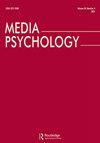Beyond User Control and Two-Way Communication: The Four-Factor Model of Interactivity of Wrist-Worn Smart Devices
IF 2.6
2区 心理学
Q1 COMMUNICATION
引用次数: 4
Abstract
ABSTRACT Wrist-worn smart devices such as smartwatches and smart health trackers have transformed the way we interact with technology. Whereas they share some commonalities with prior interactive media like smart phones, there are new interactivity elements of wrist-worn smart devices such as networking personal media and devices, adapting to personalized needs, and nudging healthy behavior. In order to investigate how these new factors can afford a unique interaction experience, the current study develops a user-driven conceptualization of interactivity in wearable technology. In Study 1, through an interview and a survey with wrist-worn smart device users, four factors that comprise interactivity of wrist-worn smart devices are identified: networking, adaptive, nudging, and multisensory. Exploratory and confirmatory factor analyses are conducted to examine the four-factor structure of interactivity and demonstrate strong reliability and convergent validity among the proposed factors. Study 2 revalidates the measurement structure of interactivity developed in Study 1 and further tests the theoretical value of the four-factor model by examining how the four factors predict usage intention mediated by hedonic and utilitarian benefits. Theoretical and practical implications are discussed.超越用户控制和双向通信:腕戴智能设备交互的四因素模型
摘要:智能手表和智能健康追踪器等佩戴在手腕上的智能设备已经改变了我们与科技互动的方式。尽管它们与智能手机等先前的互动媒体有一些共同点,但腕戴式智能设备也有新的互动元素,如联网个人媒体和设备、适应个性化需求和促进健康行为。为了研究这些新因素如何提供独特的交互体验,目前的研究开发了一种用户驱动的可穿戴技术交互概念。在研究1中,通过对手腕佩戴的智能设备用户的采访和调查,确定了构成手腕佩戴智能设备互动性的四个因素:网络、自适应、轻推和多感官。通过探索性和验证性因素分析,检验了互动的四因素结构,并证明了所提出的因素之间具有较强的信度和收敛有效性。研究2重新验证了研究1中开发的互动性测量结构,并通过考察四因素如何预测享乐和功利利益中介的使用意图,进一步检验了四因素模型的理论价值。讨论了理论和实践意义。
本文章由计算机程序翻译,如有差异,请以英文原文为准。
求助全文
约1分钟内获得全文
求助全文
来源期刊

Media Psychology
Multiple-
CiteScore
8.60
自引率
7.10%
发文量
30
期刊介绍:
Media Psychology is an interdisciplinary journal devoted to publishing theoretically-oriented empirical research that is at the intersection of psychology and media communication. These topics include media uses, processes, and effects. Such research is already well represented in mainstream journals in psychology and communication, but its publication is dispersed across many sources. Therefore, scholars working on common issues and problems in various disciplines often cannot fully utilize the contributions of kindred spirits in cognate disciplines.
 求助内容:
求助内容: 应助结果提醒方式:
应助结果提醒方式:


